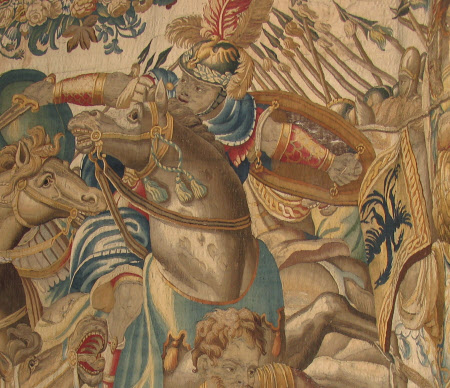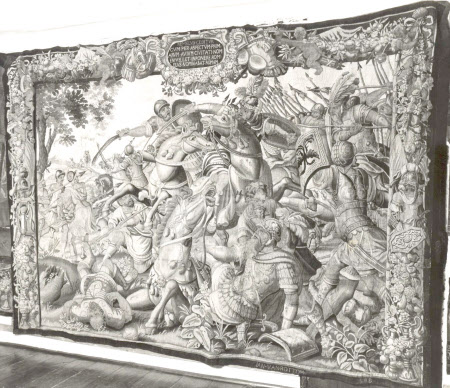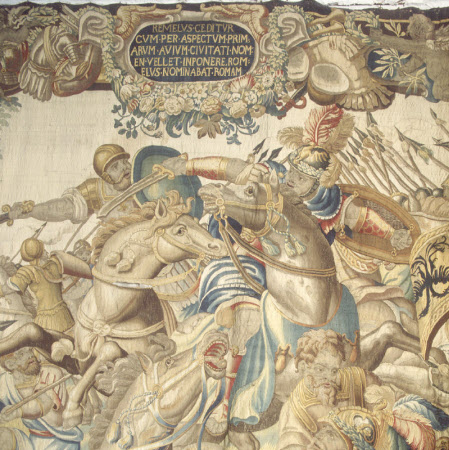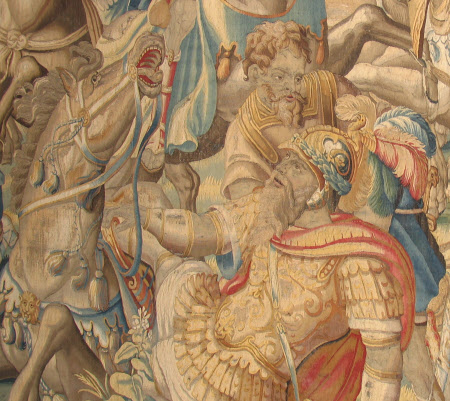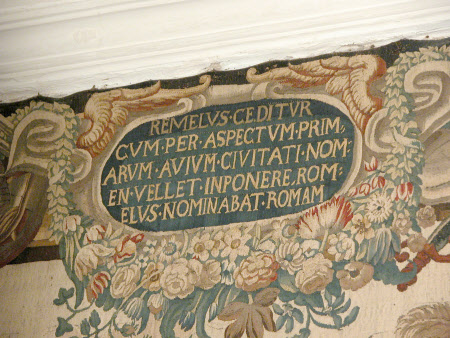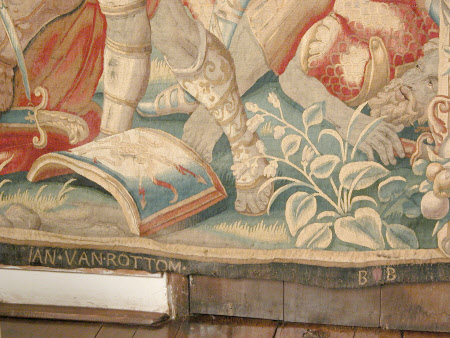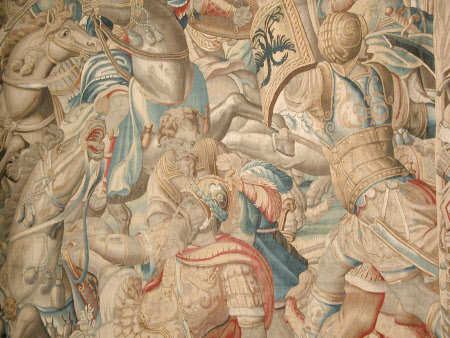The Death of Remus
Jan van Rottom (fl. 1660s)
Category
Tapestries
Date
circa 1660 - circa 1670
Materials
Tapestry, wool and silk, 7-8 warps per cm
Measurements
2800 x 3950 mm
Place of origin
Brussels
Order this imageCollection
Cotehele, Cornwall
NT 348294.4
Summary
Tapestry, wool and silk, 7-8 warps per cm, The Death of Remus from a set of five of the Story of Rome, Jan van Rottom, Brussels, c. 1660-1670. A tumultuous battle scene fills most of the main field. In the centre foreground an elderly bearded man struggles to rise and free himself from his horse which has fallen under him, his shield, decorated with thunderbolts, lying on the ground beside him. Behind him another man helps him to rise, and beyond two horsemen are locked in combat, their horses craning their necks dramatically. To the right another warrior strides into the scene carrying a shield decorated with a double-headed eagle, turning to fight off the attack of a cavalry division armed with pikes approaching from the right. To the left more men on foot and on horseback are fighting, and wounded and dying warriors lie in the foreground. On far left a group of three men armed with pikes attempt to hold off the attacking cavalry, whilst in the background on a hillside is a small scene with two men sitting on the ground, one gesturing at the sky, whilst two soldiers with pikes look on. The side borders are composed of pairs of wine jugs and spears, military trophies and swags of fruit tied with ribbons and held up by putti. In the upper border a central cartouche with a Latin inscription is framed by more military trophies, putti and swags of fruit. There is no lower border but a brown galloon bearing the Brussels city mark and the signature ‘IAN VAN ROTTOM’.
Full description
This is the fourth tapestry in the 'Story of Rome' set at Cotehele. The inscription in the upper border translates as ‘Remus is slain since, through his catching sight of the first birds, he wished to give his name to the city which Romulus was naming Rome’. Romulus and Remus had been granted permission by their grandfather Numitor to found a new city on the Palatine Hill, but both brothers wanted to give their name to the city and to be its ruler. They resolved to decide who would rule by waiting for an augury, a sign from the Gods favouring one brother or the other. Remus was the first to receive a sign in the form of six birds, but Romulus then saw twelve birds. The small group in the left background of this tapestry probably represents Romulus (who is wearing blue, as elsewhere in the set) waiting for his augury. Each brother claimed victory – Remus as he had seen his birds first, Romulus because he had seen more birds, and although the various sources differ as to how it occurred, Romulus finally murdered his brother and became sole ruler of the city which he named Rome. Although the inscription on this tapestry identifies the scene as the death of Remus, the composition is in fact taken from a different tapestry altogether, ‘Scipio Rescuing his Father at the Battle of the Ticinus’ from a series of the ‘History of Scipio’. Scipio is the central figure on horseback, and his father is the elderly man in the foreground falling from his horse. The source of the design explains why none of the main figures resembles Romulus and Remus as they appear elsewhere in the 'Story of Rome' set at Cotehele, and why the battle is on a far larger scale than the skirmish that accompanied Remus’s death in some accounts – in others he was simply murdered with a spade by Romulus or one of his men. The ‘Scipio’ series was originally woven for François I, King of France in 1532 after designs by the Italian artist Giulio Romano (Campbell 2006, pp. 364-70, with bibliography). There were a total of 22 scenes sumptuously woven with gold and silver thread, and for this reason the whole set was burned in 1797 to retrieve the precious metals. During the later sixteenth century numerous ‘Scipio’ sets were woven in Brussels based on François I’s tapestries but altering some of the original designs. Two tapestries from one of these derivative sets survive in the Museum of Fine Arts, Boston, including a version of the ‘Battle of the Ticinus’ which differs in many particulars from François I’s original, but is very similar to the tapestry at Cotehele (Cavallo 1967, pp. 109-115). The only compositional differences between the Boston and Cotehele tapestries are the addition of a group of armed men on the left hand side at Cotehele, and the small figures watching for birds in the left distance. This small group is the only thing that identifies the subject as ‘The Death of Remus’ rather than ‘The Battle of the Ticinus’, and has been added to change the subject of the tapestry design. As if this were not complicated enough, another tapestry of the same subject, the 'Death of Remus', woven by Erasmus III de Pannemaker, has the same border and the same inscription as the Cotehele version, and includes this small figure group watching for birds at the top left, but the main battle scene is almost entirely different. De Pannemaker collaborated with van Rottom on the Cotehele ‘Story of Rome’ tapestries, his signature appearing on ‘The Rape of the Sabine Women’. Like the tapestry at Cotehele, de Pannemaker’s ‘Death of Remus’ is a generic battle scene and may not have been designed to represent this exact subject. The tapestry has hung in the Red Room since at least c. 1840, when it was described by the Rev. Arundell (Arundell 1840, p. 33). The five tapestries of the ‘Story of Rome’ at Cotehele may originally have been part of a larger set. The most familiar scene from the story, showing Romulus and Remus suckled by a she-wolf, is not included at Cotehele, and elsewhere surviving weavings from the same cartoons include up to eight different scenes. With the exception of one panel, ‘The Death of Remus’ (348294.4), the designs for the series derive ultimately from a tapestry set woven in the early sixteenth century in Brussels, examples of which were acquired by both Henry VIII and Philip II of Spain in the 1540-50s (Campbell 2007, pp. 306-7; Junquera de Vega & Gallegos 1986, pp. 140-2). The designer of the original series is unknown, but it has been attributed to either Jan Vermeyen (1500-1554) or Michiel Coxcie (1499-1592). In the second half of the sixteenth century a number of tapestry sets were woven based on these designs, in some cases making alterations to the composition and arrangement (Mahl 1965; Salzburg 1987, pp. 350-354). Examples include two sets in the Kunsthistorisches Museum, Vienna, which include the same figure groups but in slightly different arrangements (Mahl 1965). Of all the surviving sets, the one known as Vienna series VIII is compositionally closest to that at Cotehele. The Cotehele tapestries however were woven later, in the second half of the seventeenth century, using updated versions of the sixteenth-century cartoons. The borders with their profusion of military paraphernalia and disporting putti are of a type commonly used on late seventeenth-century Flemish tapestries with classical subject matter. In the centre of each side border is a military trophy consisting of a suit of armour and a helmet propped up on a spear and surrounded by other martial emblems. This form of trophy derives from the memorials erected in ancient Greece and Rome to commemorate victory over an enemy, and was common in funerary sculpture throughout the Renaissance and early modern period. In the context of the ‘Story of Rome’ tapestries the trophies refer to the martial basis upon which Rome was founded. In the centre of each upper border is an oval cartouche with a Latin inscription identifying the subject of the tapestry, and either side are putti with palm branches, symbols of fame, laurel wreaths for victory, olive branches for peace, and ‘fasces’, bundles of rods tied to the shaft of an axe, a symbol of the power and authority of the Roman state. The tapestries were woven without a lower border. Three panels in the 'Story of Rome' set bear the signature of Jan van Rottom, a little-known Brussels entrepreneur whose only other recorded tapestry set is a ‘History of Troy’ dated to c. 1660 (Duverger 1986 A). A fourth tapestry in the set, ‘The Rape of the Sabine Women’ (348294.5), bears the signature of Erasmus III de Pannemaker (Brussels, 1627-1681). De Pannemaker’s signature also appears on a ‘Death of Remus’ tapestry formerly in a private collection in Germany (Duverger 1986 B, p. 114; Göbel 1923, vol. 1, p. 376, vol. 2, pl. 331). Although the main battle scene in de Pannemaker’s ‘Death of Remus’ is completele different to the Cotehele version, the two tapestries have the same border and inscription, and they share a small figure group at the top left with Romulus watching for an augury. Van Rottom and de Pannemaker obviously pooled their resources, sharing design elements such as this small figure group, using the same border designs, and sharing the production of tapestry sets such as Cotehele’s ‘Story of Rome’. It was relatively common for sixteenth-century cartoons to be re-used during the seventeenth century, in part due to the cost of commissioning new designs. Many cartoon painters operating in seventeenth-century Brussels specialised in retouching sixteenth-century cartoons, which were painted in watercolour, to ensure that they remained usable in the workshop (Brosens 2009, p. 363). In the case of the ‘Story of Rome’ not one but two sixteenth-century tapestry series have been recycled, the ‘Story of Rome’ and the ‘History of Scipio’ (see text for 348294.4, ‘The Death of Remus’). The tapestries have been given a new set of inscriptions which differ substantially from those on the sixteenth-century originals: there are many spelling mistakes and grammatical errors, and in some cases, for example ‘Romulus and Remus before Numitor’, the identification of the scene has changed completely. (Helen Wyld, 2010)
Provenance
First recorded at Cotehele c. 1840; left at Cotehele when the property was accepted in lieu of tax from Kenelm, 6th Earl of Mount Edgcumbe (1873-1965) and transferred to the National Trust in 1947; amongst the contents accepted in lieu of estate duty by H M treasury and transferred to the National Trust in 1974.
Credit line
Cotehele House, The Edgcumbe Collection (The National Trust)
Marks and inscriptions
In cartouche in upper border: REMELVS CEDITVR / CVM PER ASPECTVM PRIM- / ARVM AVIVM CIVITATI NOM- / EN VELLET INPONERE ROM- / ELVS NOMINABAT ROMAM In lower galloon: IAN VAN ROTTOM In lower galloon: Brussels city mark
Makers and roles
Jan van Rottom (fl. 1660s), workshop Giulio Romano (Rome c.1499 - Mantua 1546), designer
References
Brosens and de Laet, 2009: Koenraad Brosens and Weerle de Laet, ‘Matthijs Roelandts, Joris Leemans and Lanceloot Lefebure: new data on Baroque tapestry in Brussels’, Burlington Magazine, vol. CLI, no. 1275 (June 2009), pp. 360-367 Delmarcel, 1999: Guy Delmarcel, Flemish Tapestry, Tielt 1999 T P Wiseman, Remus. A Roman Myth, Cambridge 1995 Paulina Junquera de Vega and Concha Herrero Carretero, Catalogo de Tapices del Patrimonio nacional, volumen I: siglo XVI, Madrid 1986 Junquera de Vega and Gallegos, 1986: Paulina Junquera de Vega and Carmen Díaz Gallegos, Catalogo de Tapices del Patrimonio nacional, volumen II: siglo XVII, Madrid 1986 Duverger, 1986: Erik Duverger, ‘Een Troje-tapijt uit het Brussels atelier van Jan van Rottom van omstreeks 1660’, Artes Textiles, 11 (1986), pp. 125-148 Duverger, 1969: Erik Duverger, ‘Tapijtwerk uit het Atelier van Frans Geubels’, in De Bloeitijd van de Vlaamse Tapijtkunst, Internationaal Colloquium 23-25 Mei 1961, Brussels 1969, pp. 91-149 Cavallo, 1967: Adolpho Cavallo, Tapestries of Europe and Colonial Peru in the Museum of Fine Arts, Boston, 2 vols., Boston 1967 Elisabeth Mahl, ‘Die Romulus un Remus-Folgen der Tapisserien Sammlung des Kunsthistorischen Museums’, Jahrbuch der Kunsthistorischen Sammlungen in Wien, vol. 61 (1965), pp. 7-40 Fürsterzbischof Wolf Dietrich von Raitenau, Gründer des barocken Salzburg, exh. cat. Residenz Neugebäude & Dommuseum, Salzburg 1987 Marthe Crick-Kuntziger, ‘La Tenture de l’histoire de Romulus d’Antoine Leyniers’, Bulletin des Musées Royaux d’Art et d’Histoire, vol. IV, no. 20 (1948), pp. 50-78 Göbel, 1923: Heinrich Göbel, Die Niederlande, vol. 1 of Wandteppiche, 2 vols., Berlin 1923
